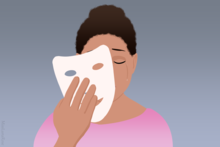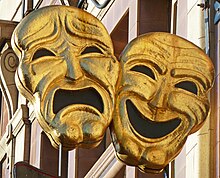가장 (성격): 두 판 사이의 차이
Mark Marcus Marco (토론 | 기여) 편집 요약 없음 태그: m 모바일 웹 고급 모바일 편집 |
Mark Marcus Marco (토론 | 기여) 편집 요약 없음 태그: m 모바일 웹 고급 모바일 편집 동음이의 링크 |
||
| 12번째 줄: | 12번째 줄: | ||
가장이란 용어는 역겨움을 감추기 위한 행동을 설명하고자 [[폴 에크먼]](Paul Ekman) (1972)과 프리젠(Friesen) (1969)이 처음 사용하였다. <ref name=DeGere>{{cite journal|last=De Gere|first=Dawn|title=The face of masking: Examining central tendencies and between-person variability in display management and display rule|journal=ProQuest Dissertations and Theses|year=2008}}</ref> 또한 그것은 학습된 행동으로 여겨졌다. 발달 연구에서는 가장 능력이 미취학 아동기에 발달하여 나이를 먹어가면서 는다고 보았다.<ref name=Cole>{{cite journal|last=Cole|first=Pamela|title=Children's Spontaneous Control of Facial Expression|journal=Child Development|date=Dec 1986|volume=57|issue=6|doi=10.1111/j.1467-8624.1986.tb00459.x|pages=1309–1321}}</ref> 최근 발달 연구에서 가장은 진화해 왔으며, 현재는 다른 감정을 표현함으로써 개인의 감정을 숨기는 것으로 정의하고 있다. 대부분은 슬픔, 좌절, 분노와 같은 부정적인 정서를 숨기고자 긍정적인 정서를 가지고 사용한다.<ref name = DeGere /> |
가장이란 용어는 역겨움을 감추기 위한 행동을 설명하고자 [[폴 에크먼]](Paul Ekman) (1972)과 프리젠(Friesen) (1969)이 처음 사용하였다. <ref name=DeGere>{{cite journal|last=De Gere|first=Dawn|title=The face of masking: Examining central tendencies and between-person variability in display management and display rule|journal=ProQuest Dissertations and Theses|year=2008}}</ref> 또한 그것은 학습된 행동으로 여겨졌다. 발달 연구에서는 가장 능력이 미취학 아동기에 발달하여 나이를 먹어가면서 는다고 보았다.<ref name=Cole>{{cite journal|last=Cole|first=Pamela|title=Children's Spontaneous Control of Facial Expression|journal=Child Development|date=Dec 1986|volume=57|issue=6|doi=10.1111/j.1467-8624.1986.tb00459.x|pages=1309–1321}}</ref> 최근 발달 연구에서 가장은 진화해 왔으며, 현재는 다른 감정을 표현함으로써 개인의 감정을 숨기는 것으로 정의하고 있다. 대부분은 슬픔, 좌절, 분노와 같은 부정적인 정서를 숨기고자 긍정적인 정서를 가지고 사용한다.<ref name = DeGere /> |
||
== 원인 == |
|||
대화 상대와의 관계, 지위차, 위치, 사회적 배경 등 맥락적 요소들은 정서를 표현하거나 억누르거나 가장하는 이유이다.<ref name = DeGere /> 가장은 정서를 숨기고 주위에서 수용되지 않는 정서를 억누르는 발식으로 행동을 가장하는 것이다. 대중의 인정을 받고자 하기에 가장은 사회적으로 수용 가능하지 않는 분노, 질투, 격노와 같은 성격을 속이는 것을 돕는다.<ref name=Malchiodi>{{cite web|last=Malchiodi|first=Cathy|title=The Healing Arts|url=http://www.psychologytoday.com/blog/the-healing-arts/201003/cool-art-therapy-intervention-8-mask-making|work=Psychology Today}}</ref>{{medcn|date=November 2017}} |
|||
=== 상황 === |
|||
* [[Personal space]]: Varies with individuals could be masking emotions to those close to them or strangers. |
|||
* Setting |
|||
=== Gender differences === |
|||
Masking negative emotions differ for each gender. Females tend to have an advanced ability when hiding their negative emotions towards something they dislike as compared to males.<ref name=Davis>{{cite journal|last=Davis|first=Teresa|title=Gender Differences in Masking Negative Emotions: Ability or Motivation?|journal=Developmental Psychology|year=1995|volume=31|issue=4|doi=10.1037/0012-1649.31.4.660|pages=660–667}}</ref> One of the possible reasons as to why females are able to mask their negative emotions better is [[Peer pressure|society's pressure]] that a girl must act nice.<ref name=Davis /> |
|||
=== Ethnicity === |
|||
Masking also differs between cultures. Some studies state that certain cultures tend to moderate their expressions of emotion while others show a greater amount of positive emotions and expressions.<ref name = DeGere /> |
|||
=== Autistic masking === |
|||
Some autistic people have been described as being able to "mask" or "camouflage" their signs of autism in order to meet social expectations. This may involve behavior such as suppressing [[stimming|self-calming repetitive movements]], faking a smile in an environment that they find uncomfortable or distressing, consciously evaluating their own behavior and mirroring others, or choosing not to talk about their interests. This may also include more complex strategies such as scripting and developing conscious 'rules' for conversations, and carefully monitoring if these are being followed.<ref>{{cite journal |last1=Hull |first1=Laura |last2=Petrides |first2=K. V. |last3=Allison |first3=Carrie |last4=Smith |first4=Paula |last5=Baron-Cohen |first5=Simon |last6=Lai |first6=Meng-Chuan |last7=Mandy |first7=William |title=“Putting on My Best Normal”: Social Camouflaging in Adults with Autism Spectrum Conditions |journal=Journal of Autism and Developmental Disorders |date=2017 |volume=47 |issue=8 |pages=2519-2534 |doi=10.1007/s10803-017-3166-5 |url=https://www.scopus.com/inward/record.uri?eid=2-s2.0-85019605045&doi=10.1007%2fs10803-017-3166-5&partnerID=40&md5=e6ccac789e51c24a3661becf716a6154 |access-date=1 July 2022}}</ref> As masking is often a conscious effort, it can be exhausting for autistic people to do this for an extended period of time (socially, but also in work contexts). In addition to making the person appear non-autistic or [[neurotypical]], masking may conceal the person's need for support.<ref name="neurology">{{cite web|first=Tara|last=Haelle|title=The Consequences of Compensation in Autism|year=2018|website=Neurology Advisor|url=https://www.neurologyadvisor.com/topics/autism-spectrum-disorder/the-consequences-of-compensation-in-autism/}}</ref> Such autistic people have cited social acceptance, the need to get a job, avoiding ostracism, or avoiding verbal or physical abuse as reasons for masking.<ref name="neurology" /> |
|||
Research has found that autistic masking is correlated with [[Major depressive disorder|depression]] and [[suicide]].<ref>{{cite journal|last1=Cage|first1=Eilidh|year=2017|title=Experiences of Autism Acceptance and Mental Health in Autistic Adults|journal=Journal of Autism and Developmental Disorders|volume=49|issue=2|pages=473–484|doi=10.1007/s10803-017-3342-7|pmid=29071566|pmc=5807490|doi-access=free}}</ref><ref>{{cite journal|last1=Cassidy|first1=Sarah|last2=Bradley|first2=Louise|last3=Shaw|first3=Rebecca|last4=Baron-Cohen|first4=Simon|year=2018|title=Risk markers for suicidality in autistic adults|journal=Molecular Autism|volume=9|page=42|doi=10.1186/s13229-018-0226-4|pmid=30083306|pmc=6069847|doi-access=free}}</ref> Many autistic adults in one survey described profound exhaustion from trying to pretend to be non-autistic.<ref>{{cite web|title=The Costs of Camouflaging Autism|first=Francine|last=Russo|website=Spectrum News|url=https://www.spectrumnews.org/features/deep-dive/costs-camouflaging-autism/}}</ref> Therapies that teach autistic people to mask, such as some forms of [[applied behavior analysis]], are controversial.<ref name="Atlantic2016">{{cite web|url=https://www.theatlantic.com/health/archive/2016/08/aba-autism-controversy/495272/|title=Is the Most Common Therapy for Autism Cruel?|last=DeVita-Raeburn|first=Elizabeth|author-link=Elizabeth DeVita-Raeburn|date=August 11, 2016|website=The Atlantic}}</ref> |
|||
== 각주 == |
|||
2022년 8월 9일 (화) 05:34 판

가장(masking)은 사회적 압박이나 학대, 괴롭힘에 굴복하여 자신의 타고난 성격(personality)을 가장(mask)하는 것이다. 가장은 권위적인 부모, 사회적 거절(rejection), 정서 학대, 신체 학대, 성적 학대 등의 환경 요소에 강력하게 영향을 받는다. 다양한 형태가 있는 행동이기에 개인들도 스스로 자신의 행동이 가장이라는 것을 모를 수 있다.
가장은 가장 행동(masking behavior)과 혼동되어서는 안된다. 가장 행동은 생존 기제(survival mechanism)로서 정신적으로 고통의 느낌을 차단하는 것이다.
역사

가장이란 용어는 역겨움을 감추기 위한 행동을 설명하고자 폴 에크먼(Paul Ekman) (1972)과 프리젠(Friesen) (1969)이 처음 사용하였다. [1] 또한 그것은 학습된 행동으로 여겨졌다. 발달 연구에서는 가장 능력이 미취학 아동기에 발달하여 나이를 먹어가면서 는다고 보았다.[2] 최근 발달 연구에서 가장은 진화해 왔으며, 현재는 다른 감정을 표현함으로써 개인의 감정을 숨기는 것으로 정의하고 있다. 대부분은 슬픔, 좌절, 분노와 같은 부정적인 정서를 숨기고자 긍정적인 정서를 가지고 사용한다.[1]
원인
대화 상대와의 관계, 지위차, 위치, 사회적 배경 등 맥락적 요소들은 정서를 표현하거나 억누르거나 가장하는 이유이다.[1] 가장은 정서를 숨기고 주위에서 수용되지 않는 정서를 억누르는 발식으로 행동을 가장하는 것이다. 대중의 인정을 받고자 하기에 가장은 사회적으로 수용 가능하지 않는 분노, 질투, 격노와 같은 성격을 속이는 것을 돕는다.[3]틀:Medcn
상황
- Personal space: Varies with individuals could be masking emotions to those close to them or strangers.
- Setting
Gender differences
Masking negative emotions differ for each gender. Females tend to have an advanced ability when hiding their negative emotions towards something they dislike as compared to males.[4] One of the possible reasons as to why females are able to mask their negative emotions better is society's pressure that a girl must act nice.[4]
Ethnicity
Masking also differs between cultures. Some studies state that certain cultures tend to moderate their expressions of emotion while others show a greater amount of positive emotions and expressions.[1]
Autistic masking
Some autistic people have been described as being able to "mask" or "camouflage" their signs of autism in order to meet social expectations. This may involve behavior such as suppressing self-calming repetitive movements, faking a smile in an environment that they find uncomfortable or distressing, consciously evaluating their own behavior and mirroring others, or choosing not to talk about their interests. This may also include more complex strategies such as scripting and developing conscious 'rules' for conversations, and carefully monitoring if these are being followed.[5] As masking is often a conscious effort, it can be exhausting for autistic people to do this for an extended period of time (socially, but also in work contexts). In addition to making the person appear non-autistic or neurotypical, masking may conceal the person's need for support.[6] Such autistic people have cited social acceptance, the need to get a job, avoiding ostracism, or avoiding verbal or physical abuse as reasons for masking.[6]
Research has found that autistic masking is correlated with depression and suicide.[7][8] Many autistic adults in one survey described profound exhaustion from trying to pretend to be non-autistic.[9] Therapies that teach autistic people to mask, such as some forms of applied behavior analysis, are controversial.[10]
각주
- ↑ 가 나 다 라 De Gere, Dawn (2008). “The face of masking: Examining central tendencies and between-person variability in display management and display rule”. 《ProQuest Dissertations and Theses》.
- ↑ Cole, Pamela (Dec 1986). “Children's Spontaneous Control of Facial Expression”. 《Child Development》 57 (6): 1309–1321. doi:10.1111/j.1467-8624.1986.tb00459.x.
- ↑ Malchiodi, Cathy. “The Healing Arts”. 《Psychology Today》.
- ↑ 가 나 Davis, Teresa (1995). “Gender Differences in Masking Negative Emotions: Ability or Motivation?”. 《Developmental Psychology》 31 (4): 660–667. doi:10.1037/0012-1649.31.4.660.
- ↑ Hull, Laura; Petrides, K. V.; Allison, Carrie; Smith, Paula; Baron-Cohen, Simon; Lai, Meng-Chuan; Mandy, William (2017). ““Putting on My Best Normal”: Social Camouflaging in Adults with Autism Spectrum Conditions”. 《Journal of Autism and Developmental Disorders》 47 (8): 2519–2534. doi:10.1007/s10803-017-3166-5. 2022년 7월 1일에 확인함.
- ↑ 가 나 Haelle, Tara (2018). “The Consequences of Compensation in Autism”. 《Neurology Advisor》.
- ↑ Cage, Eilidh (2017). “Experiences of Autism Acceptance and Mental Health in Autistic Adults”. 《Journal of Autism and Developmental Disorders》 49 (2): 473–484. doi:10.1007/s10803-017-3342-7. PMC 5807490. PMID 29071566.
- ↑ Cassidy, Sarah; Bradley, Louise; Shaw, Rebecca; Baron-Cohen, Simon (2018). “Risk markers for suicidality in autistic adults”. 《Molecular Autism》 9: 42. doi:10.1186/s13229-018-0226-4. PMC 6069847. PMID 30083306.
- ↑ Russo, Francine. “The Costs of Camouflaging Autism”. 《Spectrum News》.
- ↑ DeVita-Raeburn, Elizabeth (2016년 8월 11일). “Is the Most Common Therapy for Autism Cruel?”. 《The Atlantic》.
